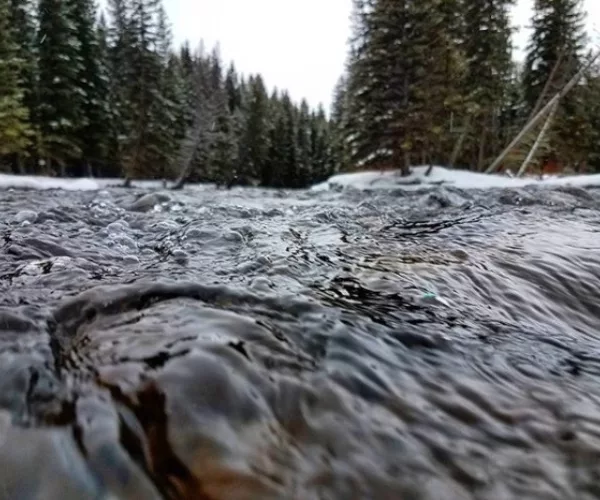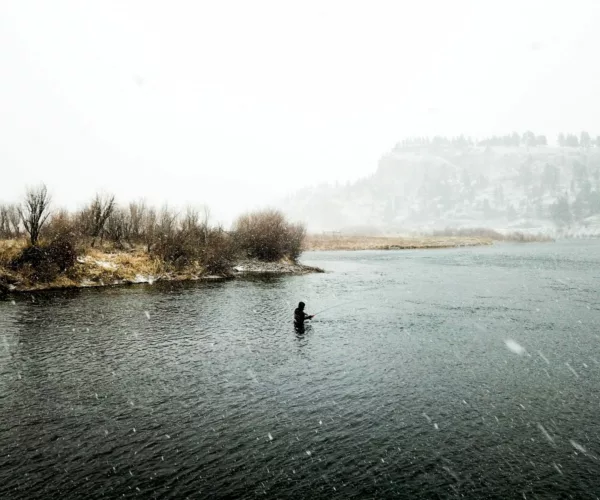Bozeman Fly Fishing in Winter
Winter in Bozeman brings cold mornings, clear rivers, and far fewer anglers on the water. The pace is slower, the techniques are simple, and the fish you do catch often feel earned. Trout don’t move much in cold water, so the focus shifts to the softer edges and deeper pools where they can hold with little effort. These are the spots worth working patiently. Instead of a handful of quick drifts, expect to run the same bucket over and over before a fish eats.
Winter Hatches for Bozeman Fly Fishing
Winter hatches in Bozeman are almost always about midges. These tiny insects are on the water day after day, even when snow lines the banks. You’ll find them clustered in back eddies and slower water, right where trout will sit to feed. Watching pods of fish sip midges in the middle of winter is a reminder that even in cold conditions, trout are still looking up.
Midge hatches usually line up with the warmest part of the day, when water temps rise just enough to get fish moving. The bugs may be small, but they can draw steady surface activity when conditions line up. Matching them with fine tippet and simple patterns is often the difference between spooking fish and hooking them. While winter doesn’t bring the variety of summer hatches, midges provide consistent opportunities, and for anglers who stick it out, they can be the highlight of a cold day on the river.
Tips For Winter Fly Fishing Bozeman
Patterns don’t need to be complicated. Small attractor nymphs like midges, eggs, and worms are the core of winter fishing around Bozeman. On warmer afternoons, midges will hatch. Having a few dry flies in your box gives you the option when that happens. Streamers can move fish, too, but in winter, they’re usually less about covering water and more about carefully fishing the right runs.
Fish don't typically sit in the faster water during the winter. Instead, they slide into slower stretches and deeper buckets where they don’t have to work as hard. These spots need more attention than they do in summer. One or two drifts usually aren’t enough. In the cold, it might take ten or more clean passes to finally get an eat. Depth control matters more than anything else this time of year. If your flies aren’t getting down to the fish, you’re not in the game. Adjusting weight or moving your indicator is often the small fix that makes the difference.
Flies for Fly Fishing Bozeman in Winter
Fly choice in the winter is straightforward. Midges are on the water every day, and they’re the main food source. A simple midge nymph under an indicator will catch fish consistently, but it’s smart to carry a few dries for those warmer afternoons when trout rise in the slower water. Eggs and worms also stay effective, and while streamers can still produce, they need to be fished slowly and deliberately through good holding water. There’s no need to pack a full box—just a handful of patterns that cover these bases is enough.
Eggs and worms are also staples during winter. Trout key on eggs as part of their cold-season diet, especially in rivers with active spawning fish upstream. Worms remain productive when midges aren’t moving or when water has a little color from melt or runoff. These flies are simple, easy to fish, and effective in deep holes and slower edges where trout stack during the coldest months.
Clear water is the norm this time of year, so presentation is critical. Lighter tippets and clean leaders make a big difference, especially on the East Gallatin where trout are quick to spook. Just as important is how you step into the river. Too many anglers cast as far as they can right away, lining every fish close to them. Fishing the water at your feet first and working out from there often produces better results. Trout won’t move far in the winter, but if your drift is natural, they’ll eat.
Winter Fly Fishing in Bozeman
Winter fishing in Bozeman isn’t about numbers. You won’t catch fish on every drift, and some days are tougher than others. But the rivers are quiet, the fish are healthy, and each one you land feels earned. For anglers who stick with it, winter is a season that offers a different kind of reward.
Fins and Feathers Guide Service has been outfitting Montana fly fishing trips in Bozeman for over two decades. Guided fly fishing trips during the wintertime are best left to last-minute bookings. Weather and water conditions can change quickly, so check with us a few days out and we will work with you to determine if a guide trip would be worth the effort and expense.
Inquire using our Contact Form or e-mail for winter guided fly fishing trips in the Bozeman area.
Related Articles From The Montana Fly Fishing Blog

Category: Bozeman Fly Fishing Trip Planning, Tips on Flyfishing Montana Rivers
Where is the Best Fly Fishing in Montana
Post Date: 03/16/2024
Trout anglers have no shortage of great places to fish. The state of Montana alone boasts enough trout water to keep you busy for several lifetimes. What’s the best trout...
Read Article
Category: Bozeman Fly Fishing Trip Planning, Tips on Flyfishing Montana Rivers
4 Best Fly Fishing Rivers in Montana
Post Date: 05/31/2024
Anglers traveling to Montana to fly fish for trout face a difficult question. Where to fish? You can’t experience all exceptional water here in a lifetime much less a single...
Read Article



